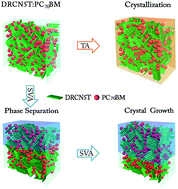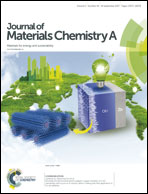Gaining further insight into the effects of thermal annealing and solvent vapor annealing on time morphological development and degradation in small molecule solar cells†
Abstract
Numerous articles on thermal annealing (TA) and solvent vapor annealing (SVA) treatments have shown that both strategies effectively improve bulk morphology, reduce carrier recombination and thus improve photovoltaic performance of bulk heterojunction (BHJ) organic solar cells (OSCs). In previous work, we found that both TA and SVA treated devices based on a blend composed of a 3-ethyl-2-thioxothiazolidin-4-one containing molecule as donor (named DRCN5T) and [6,6]-phenyl-C71-butyric acid methyl ester (PC70BM) as acceptor show the similar photovoltaic performance, but their bulk microstructures are difference. Here employing in situ photoluminescence (PL) setup and X-ray scattering technologies, we found that the early stages of SVA remarkably affect the surface of film, and in contrast TA affects the whole bulk. Meanwhile, a plurality of experimental results all further confirm the different thermodynamics and kinetics of morphology evolution processed either by TA treatment or SVA treatment. Importantly, it was found that the SVA-treated film showed the increased photo-degradation in devices as compared to the TA-treated layer, resulting from obvious bulk morphology changes under illumination over 500 hours. The aim is to provide comprehensive insight into the influence of TA and SVA on time morphological evolution and degradation in OSCs.



 Please wait while we load your content...
Please wait while we load your content...